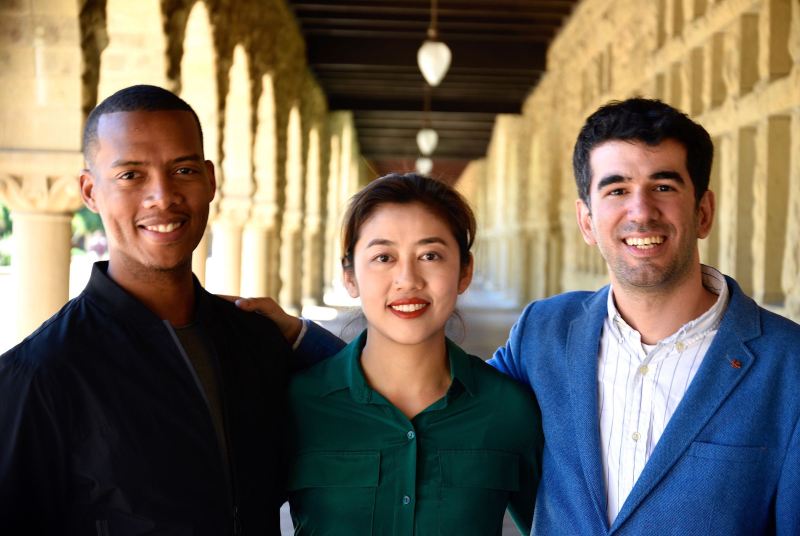Though it began just this year, the Pi Network already has more than 500,000 users, and it aims to be accessible to everyone with a smartphone. Nicolas Kokkalis Ph.D. ’13, Chengdiao Fan Ph.D. ’14, Vince McPhilip M.B.A. ’18, and visiting student researcher Aurélien Schiltz launched the network on March 14.
People generally rely on third parties to guarantee safe and reliable financial transactions. Often the third party is a bank or service such as PayPal, which costs consumers money and often places limitations on transactions. A purpose of cryptocurrencies such as bitcoin is to remove the need for a third party and its rules or fees, making financial interactions more free and beneficial for both parties involved. Bitcoin served as one of the inspirations for the Pi Network, which set out to re-imagined bitcoin as a social, mobile-first currency.
“Cryptocurrency and blockchains have the potential to decentralize financial and legal services in the same way that the internet decentralized information and media,” Fan wrote. “Unfortunately, in their current state, most cryptocurrencies remain out of reach of the everyday people who could most benefit from the technology.”
Pi aims to allow everyday people from all walks of life to contribute to the security of the cryptocurrency and the success of its community. The team believes this meritocratic principle, as well as Pi’s inclusivity, are positioning it to become the world’s most widely used cryptocurrency.
“We have dedicated our careers to unlocking human potential,” the team wrote in a statement to The Daily. “We were drawn to blockchain by its potential to achieve this goal on a global scale.”
Instead of relying on the energy-intensive algorithm used by Bitcoin to verify users, Pi secures its ledger when members vouch for each other as trustworthy. By using social “security circles” instead of an intense algorithm, Pi can be used through a free application on a typical smartphone. These interlocking “security circles” create a global trust graph showing who can be trusted to record transactions. This approach allows users to contribute to crypto mining directly from their phone by leveraging their existing social connections, with no financial cost, minimum battery drain and a lighter footprint on the planet.
Though Stanford did not provide any resources to the project, Pi’s founders note that it was largely shaped by experiences the team had at Stanford, including advice from and interactions with Stanford faculty such as computer science professors Michael Bernstein and David Mazieres, as well as bioengineering professor Jan Liphardt.
When Kokkalis taught CS 359B: “Decentralized Applications on Blockchain” in spring 2018, Fan helped organize the lectures and Schiltz was a teaching assistant for the class. The group wrote that, during that course, they saw how inaccessible blockchains were to mainstream audiences, as well as the difficulty decentralized application developers faced in reaching users. McPhilip added that his experience building the Stanford Blockchain Collective demonstrated to him that many people failed to see the relevance of blockchain.
Bioengineering professor Liphardt believes there may be applications for blockchain in healthcare, identity, and law, such as for more efficiently storing and transacting medical data. Liphardt worked with Kokkalis in Stanford’s Distributed Trust Initiative, which focuses on understanding the possible real-world uses of blockchains and related technologies.
“However good your technology is, if people can’t or don’t use it, it’s not going to have much impact,” Liphardt told The Daily. “What’s notable about the Pi team is their focus on usability and broad adoption – they are making the technology easy to use and are exploring ways of incentivizing people to keep using it.”
The team members wrote that their common goal in making cryptocurrency more accessible, along with their diverse backgrounds, enabled them to bring the concept into reality.
Toward the end of Kokkalis’ postdoc with Bernstein, he and other members of the team began researching how to make blockchain accessible to mainstream audiences, specifically relating to human computer interaction. They met regularly, beginning with work on low-fidelity and software prototypes.
“HCI is all about identifying unstated needs and assumptions in the computational systems that we inhabit, and rapidly iterating our way toward a solution that addresses them,” Bernstein wrote. “In addition, our research thinks deeply about how to design systems that encourage massive online participation … I think this project is, in some sense, a marrying of his original research interests in distributed systems together with his [Nicholas’] more recent Ph.D. and postdoc in HCI and social computing.”
According to Fan, building the world’s most widely distributed and used cryptocurrency is a multifaceted problem, involving distributed systems, cryptography, economics, law, politics and social sciences. She believes Stanford’s interdisciplinary collaboration and approaches will provide the talents needed to achieve this vision.
“I like to joke that an anthropologist, two computer scientists, and a businessman walked into a bar and asked, ‘How do we bring the power of cryptocurrency to everyday people?’ We all then decided to start a company together and eventually launched Pi Network on Pi Day 2019,” McPhillip wrote.
The Pi project is currently in Phase 1, as outlined on the project’s website, and the team is also looking for students to help in the areas of distributed systems, back-end and frond-end development, social scientists, economists and businesspeople.
Contact The Daily’s news section at news ‘at’ stanforddaily.com.
